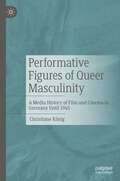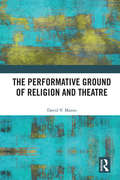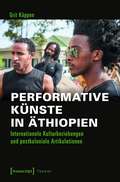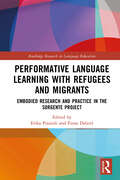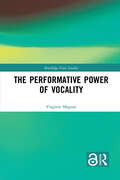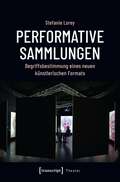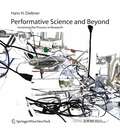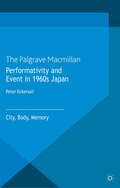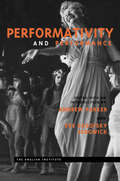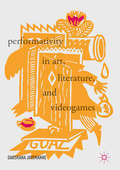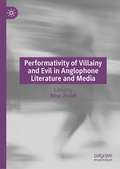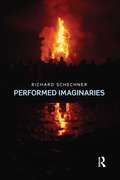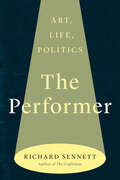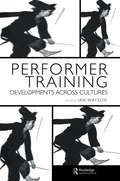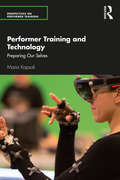- Table View
- List View
Performative Figures of Queer Masculinity: A Media History of Film and Cinema in Germany Until 1945
by Christiane KönigThis is a German history of cinema and film from the 1890s to 1945 with a focus on queer masculinity. Using media studies approaches, the study shows how film as a new medium is constituted through performative re-enactments of spectacular elements from the entertainment and knowledge cultures of the 19th century. In it, bodies, desires and identities are constantly remodelled through the formation of difference. Therefore, male queerness here does not mean the representation of male homosexuality. Rather, it is the dynamic result of complex medial processes, affects and (self-)knowledge on and off the screen. Building on Eve K. Sedgwick's queer-feminist concept of queer performativity, the author creates a historically situated model with which she traces various figures of technically anthropomorphic queer masculinity in the medium of film in an empowering sense. This book is a translation of an original German 1st edition Performative Figuren queerer Männlichkeit by Christiane König, published by J.B.Metzler, imprint of Springer-Verlag GmbH Germany, part of Springer Nature in 2020. The translation was done with the help of artificial intelligence (machine translation by the service DeepL.com). The author (with the friendly support of Megan Hanson) has subsequently revised the text further in an endeavour to refine the work stylistically. Springer Nature works continuously to further the development of tools for the production of books and on the related technologies to support authors.
The Performative Ground of Religion and Theatre
by David V. MasonReligious practitioners and theatregoers have much in common. So much, in fact, that we can say that religion is often a theatrical phenomenon, and that theatre can be a religious experience. By examining the phenomenology of religion, we can in turn develop a better understanding of the phenomenology of theatre. That is to say, religion can show us the ways in which theatre is not fake. This study explores the overlap of religion and theatre, especially in the crucial area of experience and personal identity. Reconsidering ideas from ancient Greece, premodern India, modern Europe, and the recent century, it argues that religious adherents and theatre audiences are largely, themselves, the mechanisms of their experiences. By examining the development of the philosophy of theatre alongside theories of religious action, this book shows how we need to adjust our views of both. Featuring attention to influential notions from Plato and Aristotle, from the Natyashastra, from Schleiermacher to Sartre, Bourdieu, and Butler, and considering contemporary theories of performance and ritual, this is vital reading for any scholar in religious studies, theatre and performance studies, theology, or philosophy.
The Performative Ground of Religion and Theatre
by David V. MasonReligious practitioners and theatregoers have much in common. So much, in fact, that we can say that religion is often a theatrical phenomenon, and that theatre can be a religious experience. By examining the phenomenology of religion, we can in turn develop a better understanding of the phenomenology of theatre. That is to say, religion can show us the ways in which theatre is not fake. This study explores the overlap of religion and theatre, especially in the crucial area of experience and personal identity. Reconsidering ideas from ancient Greece, premodern India, modern Europe, and the recent century, it argues that religious adherents and theatre audiences are largely, themselves, the mechanisms of their experiences. By examining the development of the philosophy of theatre alongside theories of religious action, this book shows how we need to adjust our views of both. Featuring attention to influential notions from Plato and Aristotle, from the Natyashastra, from Schleiermacher to Sartre, Bourdieu, and Butler, and considering contemporary theories of performance and ritual, this is vital reading for any scholar in religious studies, theatre and performance studies, theology, or philosophy.
Performative Künste in Äthiopien: Internationale Kulturbeziehungen und postkoloniale Artikulationen (Theater #106)
by Grit KöppenDynamik und stetige Transformationsprozesse prägen die aktuellen Kunstszenen von Addis Abeba. Aus strategischen Gründen gehen performative Künstler_innen Äthiopiens temporär auch Allianzen mit europäischen Kulturinstitutionen vor Ort ein. Durch eine Betrachtung der Geschichte und Ästhetik des äthiopischen Theaters und einer Analyse der strukturellen Bedingungen des Kunstfeldes macht Grit Köppen deutlich, dass der transkulturelle Austausch in der Kunst maßgeblich durch ein Gefüge politischer, ökonomischer, struktureller, materieller und diskursiver Machtrelationen gekennzeichnet ist. Gleichzeitig wird auf die ästhetischen Strategien performativer Künstler_innen verwiesen, in diesem Rahmen dennoch kritische, selbstreflexive und postkoloniale Artikulationen vorzunehmen.
Performative Language Learning with Refugees and Migrants: Embodied Research and Practice in the Sorgente Project (Routledge Research in Language Education)
by Erika Piazzoli Fiona DalzielThis book investigates the use of performative language pedagogy in working with refugees and migrants, exploring performative language teaching as the application of drama, music, dance and storytelling to second language acquisition.Documenting a community-based project – funded by the Irish Research Council and conducted with three groups of refugees and migrants in Ireland and Italy – the book explores the methodological, pedagogical and ethical elements of performative language learning in the context of migration. Written by a team of arts-based researchers and practitioners, chapters discuss findings from the project that relate to factors such as embodied research methods, a motivation to belong and the ethical imagination, while exhibiting how performative language pedagogy can be effective in supporting children and adults in a range of challenging contexts.Offering a poetic and pictorial representation of the Sorgente Project, this book will be of interest to postgraduate students, researchers and academics in the fields of English language arts and literacy education, drama in education, the sociology of education and second language acquisition more broadly. Those working in refugee and migrant studies, and teacher education studies will also find the volume of use.
Performative Language Learning with Refugees and Migrants: Embodied Research and Practice in the Sorgente Project (Routledge Research in Language Education)
This book investigates the use of performative language pedagogy in working with refugees and migrants, exploring performative language teaching as the application of drama, music, dance and storytelling to second language acquisition.Documenting a community-based project – funded by the Irish Research Council and conducted with three groups of refugees and migrants in Ireland and Italy – the book explores the methodological, pedagogical and ethical elements of performative language learning in the context of migration. Written by a team of arts-based researchers and practitioners, chapters discuss findings from the project that relate to factors such as embodied research methods, a motivation to belong and the ethical imagination, while exhibiting how performative language pedagogy can be effective in supporting children and adults in a range of challenging contexts.Offering a poetic and pictorial representation of the Sorgente Project, this book will be of interest to postgraduate students, researchers and academics in the fields of English language arts and literacy education, drama in education, the sociology of education and second language acquisition more broadly. Those working in refugee and migrant studies, and teacher education studies will also find the volume of use.
Performative monuments: The rematerialisation of public art (Rethinking Art's Histories)
by Mechtild WidrichThis book answers one of the most puzzling questions in contemporary art: how did performance artists of the ‘60s and ‘70s, famous for their opposition both to lasting art and the political establishment, become the foremost monument builders of the ‘80s, ‘90s and today? Not by selling out, nor by making self-undermining monuments. This book argues that the centrality of performance to monuments and indeed public art in general rests not on its ephemerality or anti-authoritarian rhetoric, but on its power to build interpersonal bonds both personal and social. Specifically, the survival of body art in photographs that cross time and space to meet new audiences makes it literally into a monument. The argument of the book spans art in Austria, the former Yugoslavia, and Germany: Valie Export, Peter Weibel and the Viennese Actionists (working in Austria and abroad), Marina Abramovic, Sanja Ivecovic and Braco Dimitrijevic (working in Yugoslavia and abroad), and Joseph Beuys and Jochen Gerz (working in Germany and abroad). These artists began by critiquing monumentality in authoritarian public space, and expanded the models developed on the streets of Vienna, Munich, Rome, Belgrade and Zagreb to participatory monuments that delegate political authority to the audience.Readers interested in contemporary art, politics, photography and performance will find in this book new facts and arguments for their interconnection.
The Performative Power of Vocality (Routledge Voice Studies)
by Virginie MagnatThe Performative Power of Vocality offers a fresh perspective on voice as a subject of critical inquiry by employing an interdisciplinary and cross-cultural approach. Conventional treatment of voice in theatre and performance studies too often regards it as a subcategory of actor training, associated with the established methods that have shaped voice pedagogy within Western theatre schools, conservatories, and universities. This monograph significantly deviates from these dominant models through its investigation of the non-discursive, material, and affective efficacy of vocality, with a focus on orally transmitted vocal traditions. Drawing from her performance training, research collaborations, and commitment to cultural diversity, Magnat proposes a dialogical approach to vocality. Inclusive of established, current, and emerging research perspectives, this approach sheds light on the role of vocality as a vital source of embodied knowledge, creativity, and well-being grounded in process, practice, and place, as well as a form of social and political agency. An excellent resource for qualitative researchers, artist-scholars, and activists committed to decolonization, cultural revitalization, and social justice, this book opens up new avenues of understanding across Indigenous and Western philosophy, performance studies, musicology, ethnomusicology, sound and voice studies, anthropology, sociology, phenomenology, cognitive science, physics, ecology, and biomedicine.
The Performative Power of Vocality (Routledge Voice Studies)
by Virginie MagnatThe Performative Power of Vocality offers a fresh perspective on voice as a subject of critical inquiry by employing an interdisciplinary and cross-cultural approach. Conventional treatment of voice in theatre and performance studies too often regards it as a subcategory of actor training, associated with the established methods that have shaped voice pedagogy within Western theatre schools, conservatories, and universities. This monograph significantly deviates from these dominant models through its investigation of the non-discursive, material, and affective efficacy of vocality, with a focus on orally transmitted vocal traditions. Drawing from her performance training, research collaborations, and commitment to cultural diversity, Magnat proposes a dialogical approach to vocality. Inclusive of established, current, and emerging research perspectives, this approach sheds light on the role of vocality as a vital source of embodied knowledge, creativity, and well-being grounded in process, practice, and place, as well as a form of social and political agency. An excellent resource for qualitative researchers, artist-scholars, and activists committed to decolonization, cultural revitalization, and social justice, this book opens up new avenues of understanding across Indigenous and Western philosophy, performance studies, musicology, ethnomusicology, sound and voice studies, anthropology, sociology, phenomenology, cognitive science, physics, ecology, and biomedicine.
Performative Representation of Working-Class Laborers: They Work Hard for the Money
by Colin Gardner Jennifer VanderpoolPerformative Representation of Working-Class Laborers: They Work Hard for the Money is a transdisciplinary anthology intersecting art theory praxis, comparative literature, film & media studies, performance art, ethnic studies, gender studies, age & aging, geography, and labor studies. The book investigates and analyzes artwork created by artists or collectives working within the dialogue of Postmodernism and current global arts production. The focus on performative aspect of labor as art and affect becomes more sensate and less about the exploited body of labourers, liberating the representation of waged bodies and further diversifying the field of Working-Class Studies.
Performative Sammlungen: Begriffsbestimmung eines neuen künstlerischen Formats (Theater #131)
by Stefanie LoreyIn ihrer künstlerisch-wissenschaftlichen Studie untersucht Stefanie Lorey erstmalig Methoden des Sammelns und Ordnens unter der Prämisse performativer Handlungs- und Präsentationformen. Vor dem Hintergrund einer eigenen langjährigen künstlerischen Biographie, die sich durch diverse performative Sammlungsformate auszeichnet, fordert und formuliert sie - als Erweiterung bereits vorhandener Attributionen in der Bildenden Kunst - eine neue künstlerische Kategorie: die performative Sammlung. Definition, Beschreibung und Ausführungen dieser neuen Kategorie bilden die Grundlage dieser Arbeit.
Performative Science and Beyond: Involving the Process in Research
by Hans H. DiebnerA coherent summary of 6 years’ research work at the ZKM Institute for Basic Research in Karlsruhe. Motto of the research, set between art and science, was "performative science”, a new research method that methodologically complements the natural sciences by means of a performative-artistic procedure. The book offers a theoretical, praxis-motivated discourse on the topic, strongly orientated towards philosophical hermeneutics but consisting to a great degree of concrete examples of application such as brain modelling, chaos research, artificial life and artificial intelligence. It provides a methodological bridge between science and art.
Performativity and Event in 1960s Japan: City, Body, Memory
by P. EckersallPerformativity and Event in 1960s Japan considers the artists and events in 1960s Japan. In response to the social upheavals of the 1960s, it shows how art interacted with society in unique and transformational ways, nterweaving arguments about the critical role of performance as an artistic medium and as a social dramaturgy.
Performativity and Performance: Performativity And Performance (Essays from the English Institute)
by Andrew Parker Eve Kosofsky SedgwickFrom the age of Aristotle to the age of AIDS, writers, thinkers, performers and activists have wresteled with what "performance" is all about. At the same moment, "performativity"--a new concept in language theory--has become a ubiquitous term in literary studies. This volume grapples with the nature of these two key terms whose traces can be found everywhere: in the theatre, in the streets, in philosophy, in questions of race and gender, and in the sentences we speak.
Performativity and Performance (Essays from the English Institute)
by Andrew Parker Eve Kosofsky SedgwickFrom the age of Aristotle to the age of AIDS, writers, thinkers, performers and activists have wresteled with what "performance" is all about. At the same moment, "performativity"--a new concept in language theory--has become a ubiquitous term in literary studies. This volume grapples with the nature of these two key terms whose traces can be found everywhere: in the theatre, in the streets, in philosophy, in questions of race and gender, and in the sentences we speak.
Performativity in Art, Literature, and Videogames
by Darshana JayemanneThis book modifies the concept of performativity with media theory in order to build a rigorous method for analyzing videogame performances. Beginning with an interdisciplinary exploration of performative motifs in Western art and literary history, the book shows the importance of framing devices in orienting audiences’ experience of art. The frame, as a site of paradox, links the book’s discussion of theory with close readings of texts, which include artworks, books and videogames. The resulting method is interdisciplinary in scope and will be of use to researchers interested in the performative aspects of gaming, art, digital storytelling and nonlinear narrative.
Performativity in Art, Literature, and Videogames
by Darshana JayemanneThis book modifies the concept of performativity with media theory in order to build a rigorous method for analyzing videogame performances. Beginning with an interdisciplinary exploration of performative motifs in Western art and literary history, the book shows the importance of framing devices in orienting audiences’ experience of art. The frame, as a site of paradox, links the book’s discussion of theory with close readings of texts, which include artworks, books and videogames. The resulting method is interdisciplinary in scope and will be of use to researchers interested in the performative aspects of gaming, art, digital storytelling and nonlinear narrative.
Performativity of Villainy and Evil in Anglophone Literature and Media
by Nizar ZouidiPerformativity of Villainy and Evil in Anglophone Literature and Media studies the performative nature of evil characters, acts and emotions across intersecting genres, disciplines and historical eras. This collection brings together scholars and artists with different institutional standings, cultural backgrounds and (inter)disciplinary interests with the aim of energizing the ongoing discussion of the generic and thematic issues related to the representation of villainy and evil in literature and media. The volume covers medieval literature to contemporary literature and also examines important aspects of evil in literature such as social and political identity, the gothic and systemic evil practices. In addition to literature, the book considers examples of villainy in film, TV and media, revealing that performance, performative control and maneuverability are the common characteristics of villains across the different literary and filmic genres and eras studied in the volume.
Performed Imaginaries
by Richard SchechnerIn this collection of essays, performance studies scholar and artist Richard Schechner brings his unique perspective to bear upon some of the key themes of society in the 21st century. Schechner connects the avantgarde and terror, the counter-cultural movement of the 1960s/70s and the Occupy movement; self-wounding art, popular culture, and ritual; the Ramlila cycle play of India and the way imagination structures reality; the corporate world and conservative artists. Schechner asks artists to redeploy Nehru's Third World as a movement not of nations but of like-minded culture workers who must propose counter-performances to war, violence, and the globalized corporate empire. With characteristic brio, Schechner urges us to play for keeps. "Playing deeply is a way of finding and embodying new knowledge", he writes. Performed Imaginaries ranges through some of the key moves within Schechner’s oeuvre, and challenges today’s experimental artists, activists, and scholars to generate a new, third world of performance.
Performed Imaginaries
by Richard SchechnerIn this collection of essays, performance studies scholar and artist Richard Schechner brings his unique perspective to bear upon some of the key themes of society in the 21st century. Schechner connects the avantgarde and terror, the counter-cultural movement of the 1960s/70s and the Occupy movement; self-wounding art, popular culture, and ritual; the Ramlila cycle play of India and the way imagination structures reality; the corporate world and conservative artists. Schechner asks artists to redeploy Nehru's Third World as a movement not of nations but of like-minded culture workers who must propose counter-performances to war, violence, and the globalized corporate empire. With characteristic brio, Schechner urges us to play for keeps. "Playing deeply is a way of finding and embodying new knowledge", he writes. Performed Imaginaries ranges through some of the key moves within Schechner’s oeuvre, and challenges today’s experimental artists, activists, and scholars to generate a new, third world of performance.
The Performer: Art, Life, Politics
by Richard SennettAn acclaimed sociologist’s exploration of the connections among performances in life, art, and politics In The Performer, Richard Sennett explores the relations between performing in art (particularly music), politics, and everyday experience. It focuses on the bodily and physical dimensions of performing, rather than on words. Sennett is particularly attuned to the ways in which the rituals of ordinary life are performances. The book draws on history and sociology, and more personally on the author’s early career as a professional cellist, as well as on his later work as a city planner and social thinker. It traces the evolution of performing spaces in the city; the emergence of actors, musicians, and dancers as independent artists; the inequality between performer and spectator; the uneasy relations between artistic creation and social and religious ritual; the uses and abuses of acting by politicians. The Janus-faced art of performing is both destructive and civilizing.
Performer Training: Developments Across Cultures
by Ian WatsonPerformer Training is an examination of how actors are trained in different cultures. Beginning with studies of mainstream training in countries such as Poland, Australia, Germany, and the United States, subsequent studies survey: · Some of Asia's traditional training methods and recent experiments in performer training · Eugenio Barba's training methods · Jerzy Grotowski's most recent investigations · The Japanese American NOHO companies attempts at integrating Kyogen into the works of Samuel Beckett · Descriptions of the training methods developed by Tadashi Suzuki and Anne Bogart at their Saratoga International Theatre Institute · Recent efforts to re-examine the role and scope of training, like Britain's International Workshop Festival and the European League of Institutes of Arts masterclasses · The reformulation of the use of emotions in performer training known as Alba Emoting.
Performer Training: Developments Across Cultures (Contemporary Theatre Studies #Vol. 38)
by Ian WatsonPerformer Training is an examination of how actors are trained in different cultures. Beginning with studies of mainstream training in countries such as Poland, Australia, Germany, and the United States, subsequent studies survey: · Some of Asia's traditional training methods and recent experiments in performer training · Eugenio Barba's training methods · Jerzy Grotowski's most recent investigations · The Japanese American NOHO companies attempts at integrating Kyogen into the works of Samuel Beckett · Descriptions of the training methods developed by Tadashi Suzuki and Anne Bogart at their Saratoga International Theatre Institute · Recent efforts to re-examine the role and scope of training, like Britain's International Workshop Festival and the European League of Institutes of Arts masterclasses · The reformulation of the use of emotions in performer training known as Alba Emoting.
Performer Training and Technology: Preparing Our Selves (Perspectives on Performer Training)
by Maria KapsaliPerformer Training and Technology employs philosophical approaches to technology, including postphenomenology and Heidegger’s thinking, to examine the way technology manifests, influences and becomes used in performer training discourse and practice. The book offers in-depth discussions of present and past performer training practices through a lens that has never been applied before; considers the employment of key digital artefacts; and develops a series of analytical tools that can be useful in scholarly and practical explorations. An array of intriguing subjects are covered including the role of electric lights in Stanislavsky’s work on concentration; the use of handheld tools, such as sticks in Zarrilli’s psychophysical training and Meyerhold’s Biomechanics; the emergence of new forms of training in relation to motion capture technology; and the way the mobile phone complicates notions and practices of attention in learning and training contexts. This book is of vital relevance to performer training scholars and practitioners; theatre, performance, and dance scholars and students; and especially those interested in philosophies of technology.
Performer Training and Technology: Preparing Our Selves (Perspectives on Performer Training)
by Maria KapsaliPerformer Training and Technology employs philosophical approaches to technology, including postphenomenology and Heidegger’s thinking, to examine the way technology manifests, influences and becomes used in performer training discourse and practice. The book offers in-depth discussions of present and past performer training practices through a lens that has never been applied before; considers the employment of key digital artefacts; and develops a series of analytical tools that can be useful in scholarly and practical explorations. An array of intriguing subjects are covered including the role of electric lights in Stanislavsky’s work on concentration; the use of handheld tools, such as sticks in Zarrilli’s psychophysical training and Meyerhold’s Biomechanics; the emergence of new forms of training in relation to motion capture technology; and the way the mobile phone complicates notions and practices of attention in learning and training contexts. This book is of vital relevance to performer training scholars and practitioners; theatre, performance, and dance scholars and students; and especially those interested in philosophies of technology.
